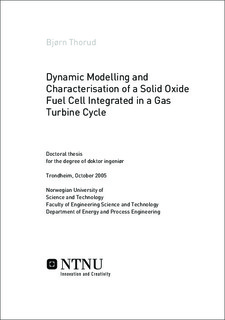| dc.contributor.author | Thorud, Bjørn | nb_NO |
| dc.date.accessioned | 2014-12-19T11:43:46Z | |
| dc.date.available | 2014-12-19T11:43:46Z | |
| dc.date.created | 2005-11-24 | nb_NO |
| dc.date.issued | 2005 | nb_NO |
| dc.identifier | 125779 | nb_NO |
| dc.identifier.isbn | 82-471-7241-0 | nb_NO |
| dc.identifier.uri | http://hdl.handle.net/11250/233387 | |
| dc.description.abstract | This thesis focuses on three main areas within the field of SOFC/GT-technology:
• Development of a dynamic SOFC/GT model
• Model calibration and sensitivity study
• Assessment of the dynamic properties of a SOFC/GT power plant
The SOFC/GT model developed in this thesis describes a pressurised tubular Siemens Westinghouse-type SOFC, which is integrated in a gas turbine cycle. The process further includes a plate-fin recuperator for stack air preheating, a prereformer, an anode exhaust gas recycling loop for steam/carbon-ratio control, an afterburner and a shell-tube heat exchanger for air preheating. The fuel cell tube, the recuperator and the shell-tube heat exchanger are spatially distributed models. The SOFC model is further thermally integrated with the prereformer. The compressor and turbine models are based on performance maps as a general representation of the characteristics. In addition, a shaft model which incorporates moment of inertia is included to account for gas turbine transients.
The SOFC model is calibrated against experimentally obtained data from a single-cell experiment performed on a Siemens Westinghouse tubular SOFC. The agreement between the model and the experimental results is good. The sensitivity study revealed that the degree of prereforming is of great importance with respect to the axial temperature distribution of the fuel cell.
Types of malfunctions are discussed prior to the dynamic behaviour study. The dynamic study of the SOFC/GT process is performed by simulating small and large load changes according to three different strategies;
• Load change at constant mean fuel cell temperature
• Load change at constant turbine inlet temperature
• Load change at constant shaft speed
Of these three strategies, the constant mean fuel cell temperature strategy appears to be the most rapid load change method. Furthermore, this strategy implies the lowest degree of thermal cycling, the smoothest fuel cell temperature distribution and the lowest current density at part-load. Thus, this strategy represents the overall lowest risk with respect to system malfunctions and degradation. In addition, the constant mean fuel cell temperature strategy facilitates high efficiency part-load operation. The constant turbine inlet temperature strategy proved to lead to unstable operation at low load, and thus it is considered to be the least adequate method for load change. For both the constant mean fuel cell temperature strategy and the constant TIT strategy, surge might be a problem for very large load reductions. The slowest response to load changes was found for the constant shaft speed strategy. Furthermore, this strategy leads to very low fuel cell temperatures at low loads. This in combination with a possible higher degradation rate makes the constant shaft speed strategy unsuited for large load variations. Nevertheless, operation at constant shaft speed may be facilitated by air bypass, VIGV or compressor blow off. | nb_NO |
| dc.language | eng | nb_NO |
| dc.publisher | Fakultet for ingeniørvitenskap og teknologi | nb_NO |
| dc.relation.ispartofseries | Doktoravhandlinger ved NTNU, 1503-8181; 2005:176 | nb_NO |
| dc.relation.haspart | Stiller, C; Thorud, B; Seljebø, S; Mathisen, Ø; Karoliussen, H; Bolland, O. Finite-volume modeling and hybrid-cycle performance of planar and tubular solid oxide fuel cells. Journal of Power Sources . 141(2): 227-240, 2005. | nb_NO |
| dc.subject | Energi- og prosessteknikk | no_NO |
| dc.title | Dynamic Modelling and Characterisation of a Solid Oxide Fuel Cell Integrated in a Gas Turbine Cycle | nb_NO |
| dc.type | Doctoral thesis | nb_NO |
| dc.contributor.department | Norges teknisk-naturvitenskapelige universitet, Fakultet for ingeniørvitenskap og teknologi, Institutt for energi- og prosessteknikk | nb_NO |
| dc.description.degree | dr.ing. | nb_NO |
| dc.description.degree | dr.ing. | en_GB |
